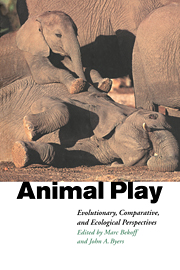Book contents
- Frontmatter
- Contents
- List of contributors
- Introduction
- 1 The evolutionary origins of play revisited: lessons from turtles
- 2 Play in common ravens (Corvus corax)
- 3 Object play by adult animals
- 4 Kangaroos at play: play behaviour in the Macropodoidea
- 5 Intentional communication and social play: how and why animals negotiate and agree to play
- 6 Structure-function interface in the analysis of play fighting
- 7 Sparring as play in young pronghorn males
- 8 Squirrel monkey play fighting: making the case for a cognitive training function for play
- 9 Self assessment in juvenile play
- 10 Biological effects of locomotor play: getting into shape, or something more specific?
- 11 Neurobiological sustrates of play behavior: glimpses into the structure and function of mammalian playfulness
- 12 Play as an organizing principle: clinical evidence and personal observations
- Index
1 - The evolutionary origins of play revisited: lessons from turtles
Published online by Cambridge University Press: 20 November 2009
- Frontmatter
- Contents
- List of contributors
- Introduction
- 1 The evolutionary origins of play revisited: lessons from turtles
- 2 Play in common ravens (Corvus corax)
- 3 Object play by adult animals
- 4 Kangaroos at play: play behaviour in the Macropodoidea
- 5 Intentional communication and social play: how and why animals negotiate and agree to play
- 6 Structure-function interface in the analysis of play fighting
- 7 Sparring as play in young pronghorn males
- 8 Squirrel monkey play fighting: making the case for a cognitive training function for play
- 9 Self assessment in juvenile play
- 10 Biological effects of locomotor play: getting into shape, or something more specific?
- 11 Neurobiological sustrates of play behavior: glimpses into the structure and function of mammalian playfulness
- 12 Play as an organizing principle: clinical evidence and personal observations
- Index
Summary
The current status of identifying nonavian reptile play
The origins of vertebrate play are obscure, but more understanding of these origins would aid greatly in clarifying and evaluating hypotheses about play (Bekoff & Byers 1981; Burghardt 1984, 1998). It has been clearly shown that some birds and most if not all groups of mammals show behavior currently classified as play (Ficken 1977; Fagen 1981; Ortega & Bekoff 1987). Is play behavior restricted to endothermic vertebrates with extensive parental care? Since the nineteenth century, during which claims for play were made for many invertebrates and vertebrates (Fagen 1981; Burghardt in press; Bekoff & Allen, Chapter 5), the generally accepted phyletic scope of play has become narrowed to the extent that it is generally limited to mammals and birds. If credible evidence for play outside of the mammalian and avian radiations is to be sought, key groups are found in the nonavian reptiles. Although I will use the term reptiles from here on, many authorities hold that reptiles are not a monophyletic group, that share a common ancestor. However, even if reptiles are monophyletic, birds would be part of that group, related most closely to crocodilians. Crocodilians are in many physiological, paleontological, and life history characteristics more similar to birds than other traditional reptile groups such as turtles. For example, crocodilians have a four-chambered heart and all show postnatal parental care, complete with a complex vocal communication system that includes ‘contact’ and ‘distress’ calls (Herzog & Burghardt 1977). As archosaurs, they share a more recent common ancestor with birds than with squamate reptiles or turtles.
- Type
- Chapter
- Information
- Animal PlayEvolutionary, Comparative and Ecological Perspectives, pp. 1 - 26Publisher: Cambridge University PressPrint publication year: 1998
- 53
- Cited by

